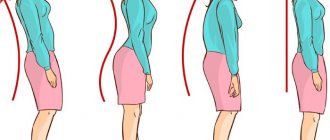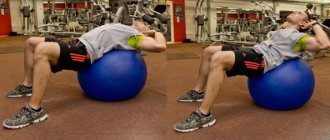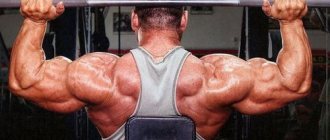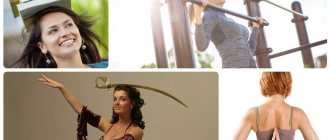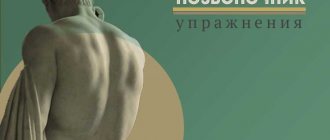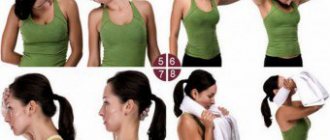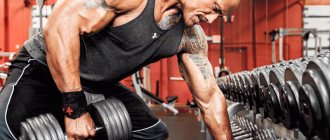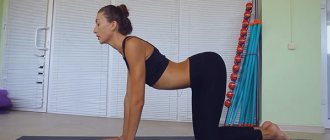es_kula
Main types of postural disorders and their diagnosis
I would like to make a reservation right away: this is not a medical article, and its author does not claim professional competence in the matter.
In addition, I will not wrap up a universal “pill” that will help everyone without exception. The text, of course, will contain many simplifications and “straightenings” of a general educational nature. My task is to talk about the basic principles, what you need to know in order to be able to listen, feel, love and take care of your own body. Perhaps this is one of the most technically complex and term-rich parts of the story :)))
So, as the Great Schemer Ostap Bender used to say in moments of deep sadness: “Do you know that every person is pressed by an atmospheric column weighing 20 tons? This morning I felt its pressure more than ever.” It was the need to resist the pressure of this very pillar, while maintaining balance and a vertical position of the body, that gave our “axis of gravity” - the spine - the very shape that it has. Our spinal column has several NATURAL curves: cervical and lumbar lordosis, thoracic and sacrococcygeal kyphosis. Animals do not have such bends.
These curves (lordosis and kyphosis) in an adult, mature person may be excessive, but remember, if someone, looking at your back, sadly shakes their head: “Ah-ah, we have kyphosis here! We’ll fix it urgently!”, - this person, kick him in the neck, at least he doesn’t understand the terminology well enough :) Kyphoidosis and lordosis of the body serve for convenient “storage” of heavy internal organs.
A very interesting comparison is given by Leopold Busquet - an orthopedist, sports doctor, osteopath - in his book “Muscular Chains”. He associates the human structure with. inflatable rubber doll. “We have many membranes: cutaneous, subcutaneous, superficial and deep (.) From the inside, these membranes are filled with organs, and muscles and bones give it all economical static.” After analyzing this ingenious system, the problems of a person who has lost weight, a person who quickly “deflates”, become clear.
The loss of elasticity of the membranes begins to be compensated by paravertebral (paravertebral) muscles, which are not at all adapted to perform this function. Therefore, a person who has dramatically lost weight experiences constant fatigue, pain in the area of muscle attachments and, as a result, tendinitis and periostitis (inflammation of the joints and tendons).
paravertebral (paravertebral) muscles
However, let's return to posture. Normal posture is one of the criteria that determines a person’s health status. But our body is a complex dynamic system, therefore the proportions, the ratio of the sizes and masses of its body are constantly changing throughout life. These changes depend on genetics, age, and are also influenced by the external environment.
Today, according to fitness statistics, for every 100 people with one or another type of postural disorder, there are only two people whose spine maintains an anatomically perfect position. Sad statistics. Even more sad are the statistics of age-related changes. Up to 60 years of age, scoliosis, thoracic kyphosis, cervical and lumbar lordosis are more often detected in women. With increasing age, the number of people with unchanged posture in a vertical position decreases sharply and the number of people with kyphotic posture increases. Torsion (twisting around its own axis) curvatures of the thoracic and lumbar spine are detected in more than half of practically healthy people of both sexes and are found more often with age.
So, the main types of deformities: Flat back (II) - an extremely rare and difficult to correct disorder (can be seen in representatives of Asian peoples, especially the Chinese and Japanese). The head is positioned straight, the neck is usually straight and long, the shoulders are noticeably lowered, “wing-shaped shoulder blades”, the stomach is retracted, the buttocks are flat. A flat back is characterized by poor development of normal curves of the spine, which results in functional inferiority of the muscles. With a flat back, the spring functions of the spine are least pronounced, which is fraught with adverse consequences during physical education and sports. Running, jumping, horse riding and cycling are especially dangerous. People with flat backs are predisposed to lateral curvatures of the spine, that is, to the formation of scoliotic posture or scoliosis. Many experts believe that the smoothness of physiological curves is the first stage of spinal osteochondrosis.
People with such posture need to work on increasing the mobility of the lumbar and sacral spine (various twisting and twisting of the spine are recommended, including using a roller that can be placed under the lower back; rolling on the mat will not be amiss). The transverse abdominal muscle requires strengthening, but hyperextension, on the contrary, should be excluded. The legs (especially the quads) need to be stretched. It is worth including in your training plan any exercises that involve bringing your shoulder blades together, for example, on a crossover or with a shock absorber.
A round back is one of the most common, but at the same time, the most easily corrected postural disorders.
This is how it looks in particularly advanced cases. The spinous processes of the spine create an arc of curvature.
Causes
Any therapy for such a pathology will not be successful if the provoking factors of its development are not identified.
It is important to remember that poor posture is always formed as a compensatory reaction to eliminate pain and discomfort.
Among the reasons that lead to the formation of a round back are the following:
- Deficit of motor activity.
- Having flat feet or club feet.
- Pathologies of the hip joints.
- Rickets.
- Serious vision problems.
- Spinal cord diseases: myelitis, poliomyelitis.
- Spinal column injuries or bruises.
- Pathological deviations in the structure of some parts of the spinal column.
- Diseases of organs located in the chest cavity.
- Mental retardation.
- Hereditary diseases of cartilage tissue.
- Vertebral instability.
These reasons are most often observed in children; in older age, the provocateurs of the formation of a round back are:
- Osteochondrosis.
- Protrusions.
- Herniated intervertebral discs.
- Osteoarthritis of the joints.
If several negative factors are combined simultaneously, the risk of pathology formation increases.
How to practice
If you're working your entire body in one workout, choose an exercise for each muscle group. If you prefer splits, take two exercises from each point and add them to your back day or deadlift day.
Some of the exercises described in the article pump up several muscle groups at once. Take this into account when creating your program. For example, you can choose one that will work both your upper and lower back well, or work these areas separately.
Select the weight of the equipment in such a way that the last repetitions in the approach are difficult, but without compromising the technique. The number of sets and repetitions will be indicated for each exercise.
How to do exercises for the latissimus dorsi muscles
These exercises will also help target the trapezius, rhomboids, infraspinatus, teres major, and teres minor muscles.
Upper pulley to chest
You can tilt the body back a little and lock it in this position. Fixation is of great importance: if you want to fully load your back, swinging must be eliminated.
Lower your shoulders and squeeze your shoulder blades together, pull the handle until it touches your chest, and then smoothly and under control return it to the starting position. There is no need to A Comparative Analysis and Technique of the Lat Pull-down raise your shoulders to your ears at the extreme point - keep them down and your shoulder blades retracted.
Perform 3-5 sets of 10-12 reps.
Pull of the lower block to the stomach
In addition to the lats, abdominal rows work well Variations in muscle activation levels during traditional latissimus dorsi weight training exercises: An experimental study of the middle trapezius and rhomboids. Therefore, if you want to pump up both the upper and lower back with one exercise, include this option in your workout.
Sit on the machine, place your feet on the platform, and grab the handle. Lower and straighten your shoulders, straighten your back. As you exhale, pull the handle toward your stomach, then return it to the starting position and repeat.
Do not jerk your back or lean back: only your arms move throughout the entire exercise.
Do 3-5 sets of 10-12 reps.
Incline Pull-Ups
Another universal exercise that works well on almost all back muscles. Unlike regular pull-ups, it is suitable for any level of training: just change the position of the body and legs, and even a beginner can do a pull-up.
Find a low crossbar. If you work out at the gym, you can use a barbell on racks. Grasp it with a straight grip slightly wider than your shoulders: this position of the hands will more engage the latissimus dorsi and trapezius muscles. If possible, do inclined pull-ups on loops or rings - this will increase the load on your back Effects of hand-grip during the inverted row with and without a suspension device: An electromyographical investigation.
Hang on the selected apparatus, tighten your abs and buttocks, and stretch your body in one line. Lower your shoulders and squeeze your shoulder blades together, pull yourself up until your chest touches and lower back down.
You can simplify the exercise in two ways: find a higher bar so that your body is in a more vertical position, or bend your knees at a right angle and place your feet on the floor.
Incline pull-ups can be made more difficult by using elevation. Place your feet on the stand so that your body is in a horizontal plane.
Perform 3–5 sets of 15–20 reps.
Straight grip pull-ups
Grasp the horizontal bar, lower your shoulders and squeeze your shoulder blades together. Pull yourself up so that your chin goes beyond the level of the horizontal bar, lower yourself back down and repeat. When doing pull-ups, do not jerk or swing. At the top point, do not pull your chin up to reach the horizontal bar; at the bottom point, keep your shoulder blades retracted.
You can make the exercise more difficult by wearing a weight belt. Instead of simplifying, it is better to replace it with lat pull-downs or Australian pull-ups.
Perform 3-5 approaches at close range.
Bent-over barbell row
Grab the barbell with an overhand grip slightly wider than shoulder-width apart. Bend your body slightly above parallel with the floor, bend your knees slightly, hold the barbell in your lowered hands, squeeze your shoulder blades together, straighten your back. As you exhale, pull the barbell toward your stomach, lower it, and repeat. Do not change your body position until the end of the exercise.
Do 3-5 sets of 8-10 reps.
WHAT IS A STRAIGHT BACK?
WHAT IS A STRAIGHT BACK?
WHICH BACK DO WE FINISH ELEVENTH GRADE?
GRADUATION IS SOON!
NORMAL POSTURE
Posture is the usual posture of a casually standing person, depending on the condition of the skeleton, musculo-ligamentous apparatus, general well-being, as well as living and working conditions. Each person has a certain, unique posture. By their posture they recognize a friend from afar, and by their posture they determine correct and incorrect statics.
Human posture is changeable: it changes throughout the day for the same person under the influence of various factors. The formation of posture is influenced by both internal factors and the external environment. The reasons for changes in statics must be sought not only in changes in the anatomy and physiology of the musculoskeletal system, but also in other organ systems.
A child beginning to walk stands on legs wide apart, bent at the knees and hip joints, his torso is straightened and tilted slightly forward. This posture manifests a lack of training in the neuromuscular system and high tension in the muscles of the anti-gravity group. This tension is the main factor that forms the physiological curvature of the spine: lumbar lordosis, thoracic kyphosis and cervical lordosis.
Changes in posture during growth are associated with the development of the nervous system, the movement apparatus, as well as with periods of intensive growth, of which two are mainly important: the period of early childhood and the period of puberty. These periods are characterized mainly by increased growth of the limbs (especially the lower ones), while the spine grows more evenly; to some extent, accelerated growth is observed during puberty.
The child’s posture begins to be determined from the moment he tries to stand independently. By this time, cervical lordosis has already formed and kyphosis is clearly visible, spreading to the thoracic and lumbar spine, resulting in a characteristic roundness of the back. Further changes in posture depend mainly on the formation of lumbar lordosis and at the same time on reducing the size of the excessive bulge of the abdomen. Lumbar lordosis finally develops only at the 7th–8th year of life. From this moment we can talk about the child’s normal posture, which is due to sufficient muscle tone. Changes in posture, characterized by laxity of the corresponding muscles (as well as an increase in the convexity of the abdomen and rounding of the back), are again observed during puberty (at the age of 13–14 years). Changes in posture and figure in general, depending on neurohormonal factors, cease with the end of puberty. Normal posture is restored, characterized by normal muscle tone. During this period, the final formation of lumbar lordosis occurs and at the same time the abdominal wall flattens.
This condition, at best, lasts up to 30 years (some researchers believe up to 25 years), after which a serious change in posture occurs due to gradually developing weakening of the muscles (mainly the abdominal muscles and extensor muscles of the trunk), an increase in body weight and the onset of degenerative process (in particular, dehydration) in the intervertebral discs. All together, this leads to increased curvature of the spine, loss of compensatory tension in the abdominal muscles and decreased growth.
Naturally, deviations from the norm in the skeleton and muscles can lead to various pathological curvatures and different types of posture, predisposing to the development of pathological curvatures of the spine. The normal, or basic, type of posture according to Stoffel is characterized by the most pronounced elastic properties of the spine, which counteract the occurrence of pathological curvatures.
Normal posture has 6 clinical signs:
- The location of the spinous processes of the vertebrae along the plumb line (vertical).
- The location of the shoulder girdles is at the same level.
- The angles of both blades are located at the same level.
- Equal triangles of the waist (right and left), formed by the torso and freely lowered arms.
- Correct curves of the spine in the sagittal plane (up to 5 cm deep in the lumbar region and up to 2 cm in the cervical region).
- With good statics, individual parts of the body behave normally, i.e. are in interaction, ensuring smooth movements and stability of support with the least amount of energy.
PATHOLOGICAL POSTURE
Although there are differences in the causes of pathological posture (postural scoliosis by English authors, pathologic posture, no Steindler) and true structural scoliosis, in the initial stage of development both forms have something in common.
The development of pathological (non-physiological) posture is based on the following unfavorable factors:
- — anatomical and constitutional type of spine structure;
- - lack of systematic physical training;
- - visual defects;
- - disorders of the nasopharynx and hearing;
- - frequent infectious diseases;
- — unsatisfactory nutrition;
- — bed with soft mesh, soft feather bed;
- — desks that do not correspond to the student’s age;
- - insufficient time for games and sports, insufficient time for rest;
- - poorly developed muscular system, especially the back and abdomen;
- - hormonal disorders and menstrual cycle disorders in girls;
- -examples of unsatisfactory posture of others (teachers, schoolmates, parents, etc.).
A number of authors consider posture disorders only as deviations in the position of the spine in the sagittal plane, which manifest themselves in an increase or decrease in the main curvatures of the spine. They classify poor posture in the frontal plane as the initial degree of scoliosis. This leads to an increase in the percentage of scoliosis and makes it difficult to carry out differentiated preventive measures to improve the health of such children.
To unify the concept of postural defect and grade I scoliosis, it is necessary to give their exact definition. It was decided to introduce asymmetrical posture into the concept of postural disorders, i.e. functional unstable deviation of the spine in the frontal plane, which can be corrected by the child himself by tensing the muscles.
The term “impaired posture in the frontal plane” was introduced instead of the previously used definitions “scoliotic setting”, “pre-scoliotic condition”, etc. This deviation is not fixed and differs from scoliosis of the first degree in the absence of morphological changes in the spine, detected by radiography.
Postural defects begin with small changes in the upper and lower parts of the body. According to the degree, postural defects can be divided into three conditional groups:
- There is a slight violation of posture, easily remedied by mobilizing the patient's attention.
- The number of symptoms characterizing defective posture increases; It can be completely corrected by traction (stretching) in a vertical position or unloading in a horizontal position of the patient.
- A combination of a postural defect with an initial form of spinal curvature.
The most common postural disorders are: flat back, round and stooped back, saddle back, often accompanied by changes in the configuration of the anterior abdominal wall.
A combination of various postural deviations is possible, such as a round-concave or flat-concave back. Often there are disturbances in the shape of the chest, winged shoulder blades, as well as an asymmetrical position of the shoulder girdle.
Types of postural disorders (V.A. Fafenrot, 1991)
| Type of posture disorder | Characteristic clinical signs |
| 1. Scoliotic posture | Deviation of the line of the spinous processes in the frontal plane, accompanied by slight asymmetry of the shoulder girdle, angles of the shoulder blades, waist triangles and pelvic position. The asymmetry disappears when lying horizontally and when bending forward. Scoliotic posture is not accompanied by rotation and torsion of the vertebrae. |
| 2. Slouch | Increased thoracic kyphosis against the background of normal or smoothed lumbar lordosis. |
| 3. Round back | Total gentle kyphosis, the apex of kyphosis is displaced caudally, lumbar lordosis is absent. |
| 4. Round-concave back | Increase in all physiological sagittal curves of the spine. |
| 5. Flat back | The physiological curves of the spine are smoothed or absent. |
| 6. Flat-concave back | Smoothness or absence of thoracic kyphosis against the background of preserved or enhanced lumbar lordosis. |
| 7. Flat-convex back | Absence of physiological thoracic kyphosis against the background of pathological kyphosis of the lumbar region. |
A flat back is characterized by smoothness of the normal curves of the spine and protruding backward (pterygoid) shoulder blades. The tilt of the pelvis with this postural defect is insignificant, which is a predetermining point in the occurrence of a flat back. The anteroposterior size of the chest is actually reduced, since in people with a flat back there is no thoracic curve at all or it is quite weakly expressed. This negatively affects the development and position of the internal organs of the chest cavity, in particular the lungs.
The straight position of the spine and the forward position of the chest (this impression is created due to the fact that the ribs along with the vertebrae are pushed forward) give a misleading idea of good alignment and posture.
Clinically characteristic are:
- - plank back;
- - pterygoid blades;
- - flat lower back;
- - flattened buttocks;
- - sluggish, poorly developed muscles;
- - pain in the lumbosacral spine, which obviously depends on overload of the ligamentous apparatus of the spine with weak paravertebral muscles.
A round and stooped back represents poor posture , which is typically characterized by a C-shaped curvature of the entire spine. Due to the forward hanging shoulders, the chest appears sunken.
A patient with a round back often stands on half-bent legs and thereby, as it were, compensates for the weakly expressed lumbar curve forward. A round back leads to a decrease in the respiratory excursion of the chest (i.e., the difference between the circumferences of the chest during inhalation and exhalation), since a full inhalation can only be taken with maximum extension of the spine.
A decrease in chest excursion entails a decrease in the vital capacity of the lungs and fluctuations in intrathoracic pressure. The latter can negatively affect the functions of not only the respiratory, but also the cardiovascular systems (due to the fact that the suction effect of the chest during breathing, which promotes blood flow through the veins to the heart, decreases).
Having arisen as a functional curvature of the spine, as a defect in posture, a round back can subsequently cause compression (compression) of the intervertebral discs and vertebral bodies (in the anterior part), which causes a disruption in their blood supply and, consequently, nutrition. This leads to degeneration of the anterior longitudinal ligament and the spinal discs themselves and the formation of a fixed curvature of the spine like a round back.
A stooped back differs from a round one only in that an excessive backward convex bend is formed in the upper part of the thoracic spine.
With a hunched back (or slouch), cervical lordosis is often increased.
A flat-concave back is characterized by a lumbar curvature of the spine , which is caused by an excessive tilt of the pelvis. This defect is accompanied by changes in the abdominal muscles. Weakness of the abdominal muscles contributes to prolapse of the internal organs of the abdominal cavity, which often causes great suffering for the patient.
Combined postural disorders. Various postural disorders can be combined.
For example, with a round and flat back, there may be an increase in the lumbar curvature of the spine.
OPTIONS FOR POSTURAL DISORDERS
A round-concave back is more common than others and is some reflection of normal posture, since the physiological curves of the spine in this case are emphasized. It is characterized by increased curvature of the spine in the anteroposterior direction. The magnitude of lumbar lordosis depends on the degree of forward tilt of the pelvis: the more the pelvis is tilted forward, the deeper the curvature of the spine will be in the lumbar region. Deepened lumbar lordosis, in turn, is compensated by an increased curvature of the thoracic spine, and the latter is balanced by increased cervical lordosis.
Consequently, with this pathology of posture, a stoop and a saddle-shaped back seem to be combined.
With a round-concave back, sometimes the stomach and buttocks protrude very significantly, and the chest seems flattened. This depends on the large inclination of the ribs associated with the increased curvature of the upper thoracic spine. Significant inclination of the ribs and increased lumbar curve in patients lead to the fact that the waist, as a rule, is somewhat shortened and thickened.
A flat-concave back is less common and predominantly occurs in women. This postural disorder is characterized by a strong forward tilt of the pelvis and a slight displacement of it backwards. Externally, this is manifested by an emphasized protrusion of the pelvis backwards, an increase in lumbar lordosis and a flattening of the thoracic and cervical curves. With this defect, the line of the center of gravity passes in front of the hip joints, so the pelvis, together with the torso, tilts forward even more, resulting in an imbalance of the body. This imbalance is corrected by deepening the lumbar lordosis. Its peculiarity is that the spine from the top of this curve goes vertically upward without the transition of the lumbar curve to the thoracic curve. With this deviation in posture, lateral curvatures of the spine are less common.
The above options are not organic pathology in the true sense, but rather represent constitutional options for the structure of the spine and the human body as a whole.
However, they must be assessed in a timely manner when examining a teenager, since an undoubted connection between the origin of a number of diseases and the constitution has been established.
With pathological posture, attention is drawn to the constantly observed flattening of the muscles on one side of the neck and the asymmetrical arrangement of the shoulder girdles, which is especially noticeable upon palpation.
With the so-called passive posture (“stand as comfortably and habitually”), the shoulder girdle (usually on the right) is shifted forward, the spinous processes form a small and unstable scoliotic arch, the shoulder blades are located asymmetrically, and the muscles are flabby. In the position of active posture (“stand up straight”), the pathological posture is corrected, the lateral curvature of the spine disappears, and the mutual perpendicularity of the three main planes of the body is restored.
An X-ray of the spine with pathological posture gives more negative than positive results. Usually there are no signs of rotation of the vertebrae, so characteristic even of the initial phase of true (structural) scoliosis. The shape and structure of the vertebral bodies reflect the physiological norm, the epiphyses develop naturally. On an x-ray taken in a standing position, sometimes the spaces between the thoracic bodies appear closer together due to uniform kyphosis; in the lateral projection of the spine in the lumbar region, lordosis is slightly increased. In the thoracic region there may be a slight lateral curvature of the spine, which, however, is not detected by x-ray in a horizontal position. In girls of the asthenic type with mild thyroid dysfunction, slight atrophy of bone tissue in the vertebral bodies is sometimes observed. If this is accompanied by abnormal development of the epiphyses of the vertebral bodies, then patients with such a pathology must be separated from the group of children with pathological posture and referred to an orthopedic doctor for observation and treatment. It is also necessary to keep in mind the possibility of radiological interpretation of “pseudoscoliosis” due to improper positioning of the child. In these cases, the radiologically detected changes do not coincide with the clinical picture, in which the asymmetry completely disappears when the patient is tilted.
So, speaking about pathological posture , one should distinguish between its two forms:
- when the deformity develops in the sagittal plane
- when the curvature develops in the frontal plane.
But such a strict “geometric” separation of deformations is not always possible. Mixed forms of spinal curvature disorders are often observed: lateral deviation is combined with kyphotic unstable deviation.
Their most significant difference from true scoliosis is that with various forms of pathological posture there are no signs of rotation at the site of the curvature and there are no other organic or structural changes in the vertebral bodies that cause clinically detectable paravertebral asymmetry.
With pathological posture, functional impairment of muscle coordination and self-control predominates.
For many people, posture problems begin in school. And by the eleventh grade we get what we get!
In our clinic we treat spinal curvatures in the initial stage with underwater massage (hydromassage) and underwater traction.
The complex also includes various physiotherapeutic procedures (magnetic therapy, electrophoresis, etc.). Their role in correcting postural disorders is great.
How to do exercises for the trapezius muscles of the back
Barbell row to the chin
Do 3-5 sets of 8-10 reps.
Reverse dumbbell swings lying on your stomach
Lie on your stomach on an incline bench, take dumbbells, turn your hands back to front. As you exhale, spread the dumbbells to the sides, while simultaneously turning your hands with your thumbs up. Lower back down and repeat.
Do 3-5 sets of 10-12 reps.
IYT climbs
Lie on your stomach on an incline bench, hold dumbbells in your hands. As you exhale, raise your arms above your head with the backs facing up and then lower them to the starting position.
Now raise your arms up diagonally so that your posture resembles the letter Y, with your palms facing upward with your thumbs. Lower to the starting position.
Then spread your arms out to the sides with your thumbs up so that your body resembles the letter T. Lower to the starting position. This was one approach.
Do the same 3-5 times for 4-5 repetitions.
How to do back extensor exercises
These two best exercises are Trunk muscle activity during stability ball and free weight exercises; Muscle activation during various hamstring exercises for the back extensors work well on the entire posterior chain, including the glutes and hamstrings.
Deadlift
Stand over the barbell with the bar over the laces of your shoes. Push your hips back, bend over with a straight back, and grab the barbell with an overhand grip slightly wider than shoulder-width apart.
As you exhale, straighten your hip and knee joints, keeping your back straight. Bring the barbell close to your shins, almost touching them. Lower it to the floor and repeat.
Perform 3-5 sets of 6-8 reps.
Hyperextension on GHD
This exercise is often used at the beginning of a workout to warm up and strengthen the back, buttocks, and hamstrings.
Place your feet under the rollers of the GHD machine and place your hands behind your head. Lower your body and then return to the starting position. At the top, rise above the parallel of your back with the floor and look forward. Perform smoothly and under control, without rocking or jerking.
Do 3-5 sets of 15-20 reps.
Hold it to failure for as long as you can. Perform 3 sets.
Signs and treatment of round-concave back
A round-concave back is a postural disorder that is characterized by an increase in all curves of the spine, including the thoracic, sacral, lumbar and cervical. In this case, there is a significant shift in the center of gravity, which greatly affects a person’s gait. The peculiarity of this pathology is that a patient with this diagnosis begins to bend his legs in a standing position.
When all lordosis and kyphosis increase, which is what happens with a round-concave back, the center of gravity shifts, which is expressed in increased pressure on the pelvic area and leg joints. Therefore, over time, this pathology leads to arthrosis, displacement of internal organs, and changes in gait.
The severity of symptoms will depend on which part of the spine is affected the most. For example, with increased thoracic kyphosis, the patient may experience symptoms such as:
- Difficulty breathing.
- Chest deformity.
- Violation of heart activity.
- Pain in hands.
At the same time, the signs of a round-concave back disappear when a person assumes a horizontal position. This is due to the fact that the muscle corset is able to support the spine in the only correct physiological position for it.
Why does thoracic kyphosis increase?
At 6-8 months of age, the child first tries to sit up on his own. By this time, his musculoskeletal system has already become sufficiently strong due to crawling and is ready for such loads. Some inquisitive toddlers make their first attempts to master vertical space much earlier, at 4-5 months, and parents, filled with pride in their child, rush to put more pillows under the fragile back.
The baby, whose muscles are not yet able to support the spine, falls back or sideways onto them.
And how many unnecessary things young, inexperienced mothers try to do so that their baby takes the first step sooner!
Early planting may cause round back development
Unfortunately, such haste often leads not to the great exploits of the young discoverer, but to the fact that a year-old child sits with a round back. The reason for this is muscle flaccidity, to which chubby or, conversely, premature babies with low weight are more prone. Therefore, if the baby is in a hurry to sit down, work with his muscles: having laid the baby on his back, put your index fingers in his hands and slightly pull him towards you. However, it is worth remembering that a round back at an early age can also be one of the manifestations of rickets.
In addition to errors in early physical education, the reasons for increasing thoracic kyphosis in children can be:
- Congenital pathology of the spine, feet, joints of the lower extremities; intrauterine disorders leading to underdevelopment of the vertebrae or the formation of wedge-shaped vertebral bodies.
- Severe diseases of the musculoskeletal system in childhood (rickets, tuberculosis, polio, etc.)
- Eye diseases, due to which the child conducts educational activities in an incorrect working position.
- Failure of the muscle corset due to incorrect postures when working at a desk, computer, or while sleeping (the child sleeps curled up).
In adults, a round or concave-round back often results from the late stages of osteoporosis and osteochondrosis, diseases of the spine accompanied by the formation of tumors. Forced, “incorrect” postures when conducting professional activities also contribute to the “rounding” of the back.
How to correct pathology
The most important thing when treating a round-concave back is to correct all existing pathological curvatures of the spine. Today, corsets and therapeutic exercises are increasingly used for these purposes. Moreover, exercises should be selected very carefully, because their main task is to eliminate the existing spasm of skeletal muscles.
The first thing to start with is to stand near a wall several times a day and rest your shoulders, the back of your head, and your buttocks against it. It is advisable to draw in your stomach as much as possible. This exercise helps to form correct posture, so you need to do it regularly. The duration can be from a minute to three. After this, you must definitely walk around the room, trying not to bend your back, but keep it in the same position as near the wall.
The second exercise for a round-concave back is performed as follows. In a horizontal position, you need to inhale and draw in your stomach as much as possible, and as you exhale, sit down on your heels. After this, kneel down and inhale again. The number of repetitions can be from 8 to 10.
The third exercise is performed in a standing position. To do this, you need to cross your fingers behind your back and change their position every 10 seconds. This exercise helps to get rid of lateral scoliosis if it is present. Each time you should perform 4–6 repetitions.
When diagnosed with a round-concave back, it is very important to train not only the thoracic, lumbar and other parts of the spine, but also the abdominal muscles. The easiest way to do this is with the following exercise: first take a shallow breath and draw in your stomach, then straighten your chest as you exhale. The number of exercises should not exceed 4 - 6 in one approach.
Treatment of a round back in a child
In childhood, it is easiest to correct the pathology; the skeletal system is not yet formed and can be easily corrected. When treating poor posture in a child, it is important to follow the following principles:
- Provide favorable conditions for the functioning of the spinal column.
- Strengthen the muscle corset and improve the child’s physical capabilities.
Therapy begins with compliance with a general hygienic regime, which involves:
- A balanced diet containing all important vitamins and minerals.
- Frequent walks in the fresh air.
- A good night's sleep on an orthopedic mattress and pillow.
- Compliance with the study and rest regime.
- Carrying out hardening procedures.
Doctors often recommend wearing corsets to correct a round back, but they give the desired effect, but it disappears immediately after you stop wearing it. This can be explained by the fact that correctors and corsets deprive muscle fibers of the ability to stabilize the spine during movement; they take over this function.
It is more effective to strengthen your own muscle frame, therefore the following are shown:
- Massage.
- Physiotherapeutic procedures.
- Physiotherapy.
Exercises for a round back can be used as follows:
- Stand straight, put your hands on your shoulders. Bend your torso forward and backward. The back should be straight.
- Squats, holding a gymnastic stick in your hands in front of you.
- In a standing position, inhaling, lift the stick up, and exhale, return back.
- In a standing position, bend your hands back on your waist, arching your back, and pull your elbows back.
- Lying on the floor, on your stomach, raise your upper body, bending at the lower back.
Parents should understand that the result of therapy depends on the regularity and correct execution of exercises.
Basic Rules
When treating round-concave back with exercises, several important rules must be followed. Strength and range of motion should be increased gradually from session to session. If pain occurs in the spine while performing one or another exercise, you need to stop exercising, consult a specialist and choose another, more gentle complex for yourself.
Many exercises for this postural pathology train not only the back muscles, but also many other muscles that are in close proximity. However, to achieve this, you must perform all the exercises regularly and correctly.
If you have a strongly protruding abdomen, you need to choose those exercises that could only affect the abdominal muscles and would not affect the lower back muscles in any way.
Symptoms
A round back in a child is manifested by shoulder blades sticking out like wings; also in adults and children the following can be noted:
- The shoulder girdle is raised up.
- The stomach protrudes forward.
- The buttocks become flattened.
- The chest is sunken.
- The arms are placed in front of the body due to the shoulders being pulled together.
- If you bend forward, you can see the protruding spinous processes in the thoracic region.
When pathology develops, spinal movements are not limited.
Prevention
Prevention of such a pathology as round-concave back is based on the exclusion of provoking factors. This can be a general improvement of the body, an individual approach or social preventive actions.
General wellness includes measures to reduce the load on the spine and correct movements, as well as eliminating certain consequences of spinal disease that can lead to a deterioration in general condition.
Individual prevention includes measures that will help a person reduce the provoking effects of those factors that affect the curvature of posture. This can be either regular gymnastics or hardening, as well as proper nutrition with plenty of vegetables and fruits.
Social prevention is aimed at improving working conditions, and with a round-concave back it is very important to create an optimal work and rest regime that would help prevent the further development of the pathology itself and become a factor that would help protect a person from all kinds of complications.

